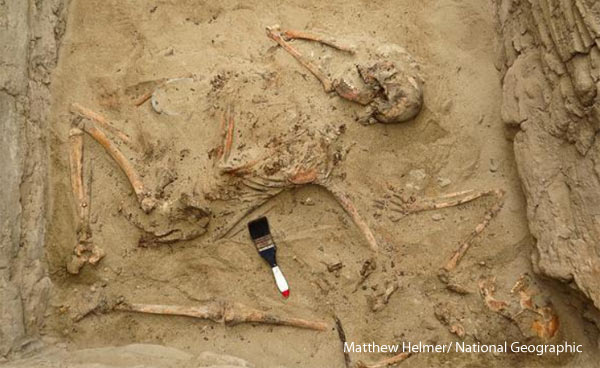Archaeologists discover tomb of ancient Peruvian culture
Archaeologists in Peru have discovered a tomb containing multiple burials belonging to the Chimú culture in the Samanco archaeological complex, a small urban trading town located in the lower Nepeña Valley on the arid, mountainous Peruvian coast. According to researchers, the burial brings a new understanding of the relationship between the Chimú and their conquerors, the Incas.
The Chimú culture is believed to have emerged out of the remnants of the Moche civilization in approximately 900 AD. They resided on the north coast of Peru in a narrow strip of desert, 20 to 100 miles wide, between the Pacific and the western slopes of the Andes. The Chimú are known for their black ceramics, intricate works with precious metals, and textiles made from alpaca wool. However, in 1470, they were conquered by the Inca under Pachacuti Inca Yupanqui and his son Topa Inca Yupanqui. The Inca absorbed much of the Chimú high culture, including their political organization, irrigation systems, and road engineering, into their own imperial organisation.
The recently discovered tomb in Samanco dates to the 15 th or 16 th centuries, shortly before the conquest of Peru by the Spanish. It contained the remains of six people and a number of grave goods including fine textiles, jewellery, and musical instruments. Archaeologists Matthew Helmer and Jeisen Navarro, who investigated the site, said that the objects suggest that the individuals buried in the tomb were noble musicians and weavers, with the exception of two women who appear to have been sacrificed to accompany the deceased elite into the afterlife.
“This is one of the very few Chimú-Inca tombs ever excavated. It reveals interesting details about the coastal Andean world just prior to European contact,” said Helmer.
Helmer suggested that the discovery reveals new information about Inca-Chimú relations, saying “Although the Chimú warred with the Inca before being conquered, grave goods like this indicate that the Incas allowed previous coastal beliefs to continue rather than impose their own pantheon during the consolidation of their empire.”
However, it seems equally likely that surviving members of the Chimú culture went to great lengths to hide their traditions from their fierce conquerors and that this was not a case of being “allowed” to continue practicing their beliefs.



















